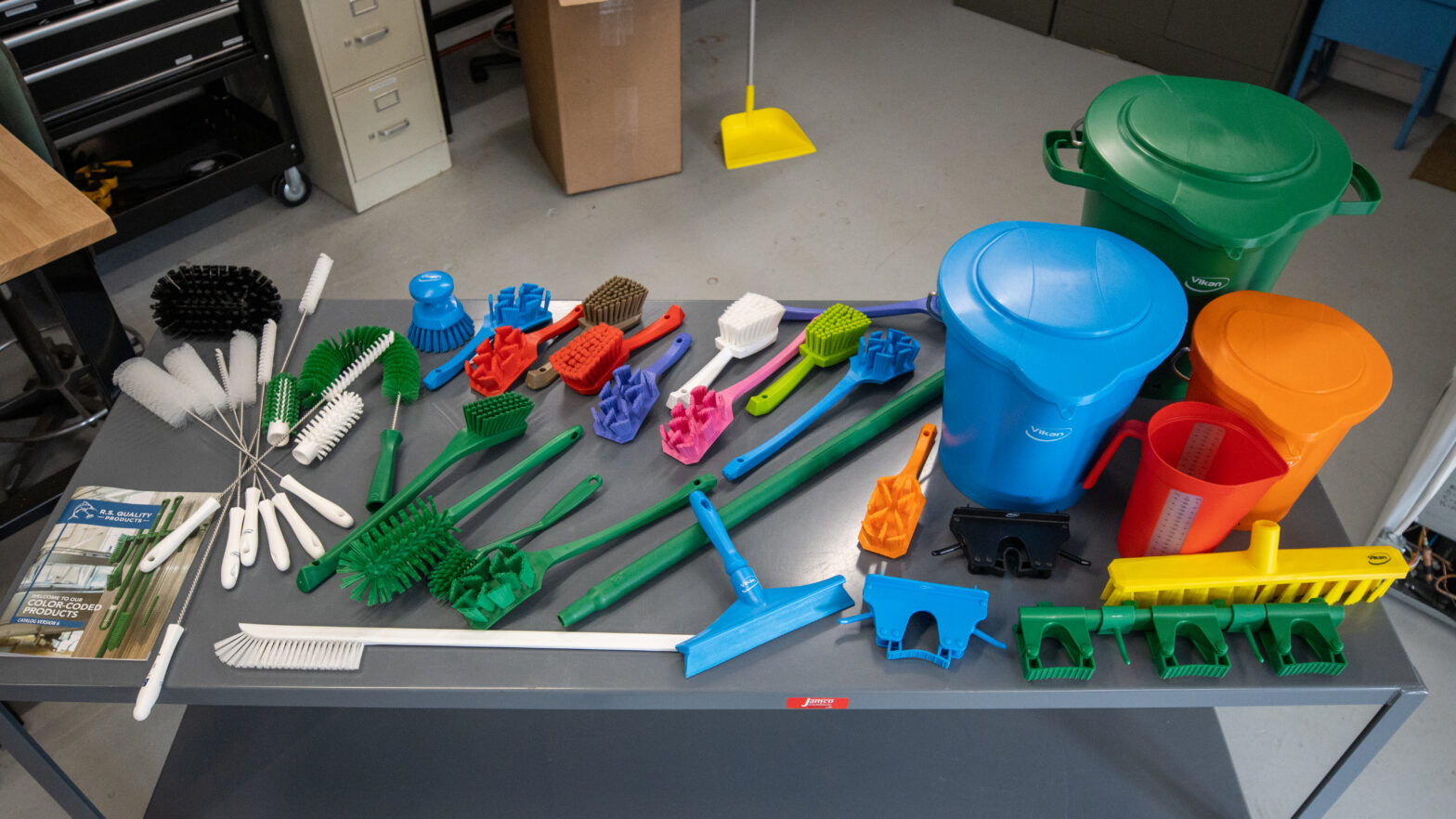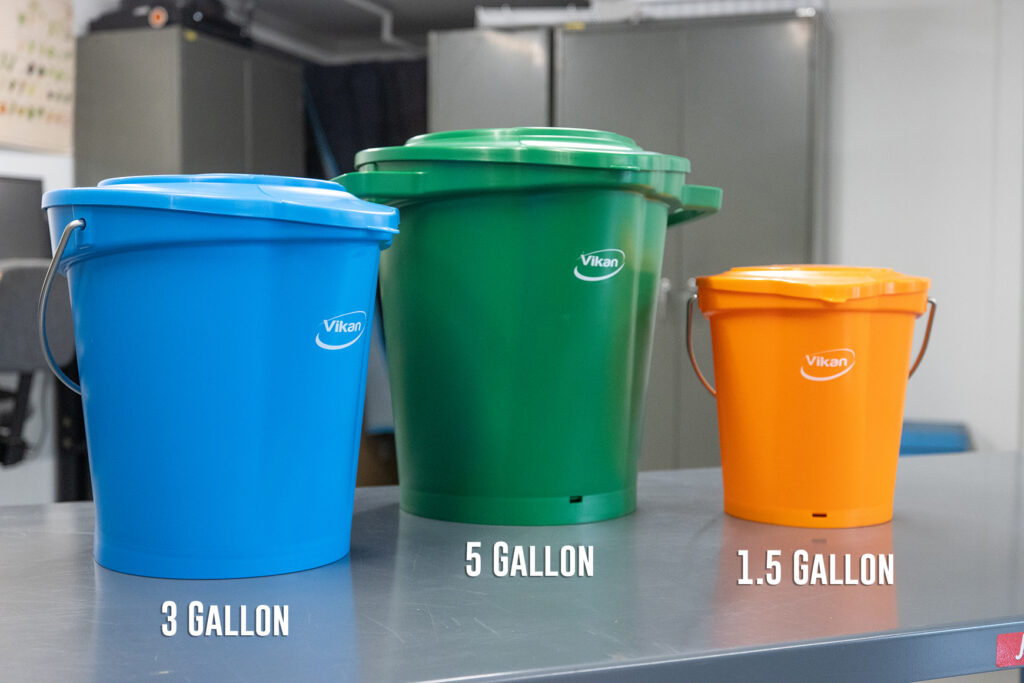Table of Contents
Brushes
Brooms
Scrapers
Squeegees
Mops, Sponges & Scrubbers
Buckets & Caddies
Accompanying Tools
Labeling
Color Coding
Purchase Locations
Video Overview
A PDF of this resources is available here.
Farms of various sizes all have tools and equipment that need to be cleaned and sanitized. This equipment varies in how well it has been designed to be cleaned; its level of hygienic design. Some items require lots of effort and specific tools to clean adequately while others are straight-forward. What’s the best brush to clean totes? Is spending money on an expensive squeegee to get water off the floor worth it ? This blog post will highlight some of the things to look for in cleaning tools and supplies for use on the farm.
Janitorial supplies on the market are generally targeted towards hospitality, schools, or restaurants, but there isn’t much out there specific for agriculture. Though not required, it might be a good idea to invest in tools for the farm that are designed for the food manufacturing industry. These will be durable items that promote the cleaning of food contact surfaces, and reduce the risk of spreading germs and contaminants. The right cleaning tool, used appropriately and regularly, can improve produce safety and also reduce postharvest spoilage.
The first question to ask yourself is “Does it need to be cleaned? And, if so, how frequently?” Not everything needs to be kept sparkling clean, and not everything should be cleaned with soap and water. There are various easy ways to achieve “clean” based on the item’s intended purpose. Starting with a visual inspection you can ask yourself some of the following questions:
- Is it a food contact surface?
- Zone 1 – Critical to clean, regularly
- It is adjacent to food contact surfaces?
- Zone 2 – Very important to clean, regularly
- Is it contributing to a dirty environment?
- Should be cleaned routinely
- Is this equipment generally a wet environment or dry?
- It may not be a good idea to introduce water in an otherwise dry production line. Dry soil or leaves can be removed with a vacuum or broom and dust pan.
You can learn more about the Zone Concept here in this article from PennState Extension.
Once you have determined the level of clean that is needed you can choose the best tactics and tools to complete the task. To learn more about the process of cleaning and sanitizing read A Guide to Cleaning, Sanitizing, and Disinfecting for Produce Farms.
We also have standard operating procedures (SOPs) to clean specific equipment on our SCRUB resources page.
How Will You Clean Your Cleaning Tools?
One of the key questions to ask is how cleanable are the tools I use to clean the other equipment and tools? It may seem like a silly question, but think about it for a moment. That brush you use to clean food contact surfaces is essentially a food contact surface itself. Would you eat off of it? We’ve explored tools on the market and have tried to summarize them below based on consideration of how they can be cleaned.
Vikan/Remco Products
The majority of the equipment shown below are tools manufactured by the company Vikan out of Denmark, or Remco, the US manufacturer of these products. They are used in the food industry and designed to be easily cleaned. We have found their design to be superior to the general cleaning tools more regularly available locally. They have implemented various features like a smooth surface texture, ergonomic handles, and Ultra Safe Technology (UST) which is brush design that has the bristles molded into the handle of the brush as opposed to the more traditional drill and staple or resin-set designs. You will note that these tools have minimal seams, holes, and crevices. Where there is a seam, such where the head screws onto a seperate handle, the connection is made to come apart and be easily cleaned.
Cleaning Tools
Brushes
When you think of cleaning tools, brushes seem to be what comes to mind first. A brush should be of high quality to withstand repeated use. Handle shape and length is important so it is ergonomic to use. It should be properly sized for the object being cleaned. The head should be small enough to reach the smallest corners and the handle should be long enough to let you reach those corners. Here are a few different types to consider.
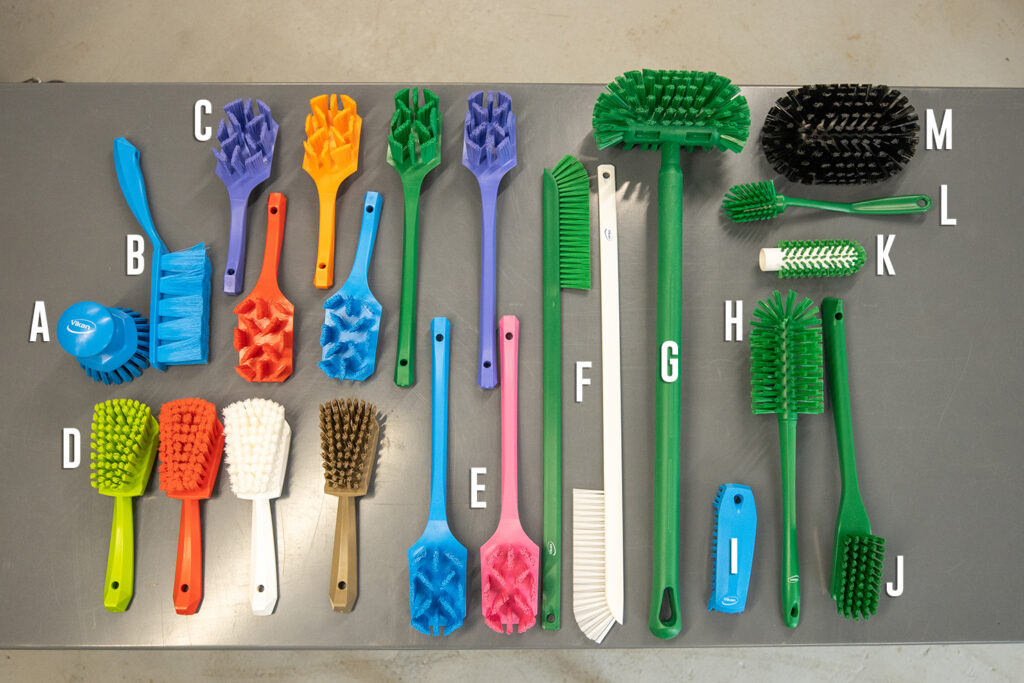
The key design features that separate one brush from another are:
- Bristles (soft/stiff)
- Drill & staple, resin set or UST molded
- Head (size & shape)
- Handle (length)
Tube Brushes
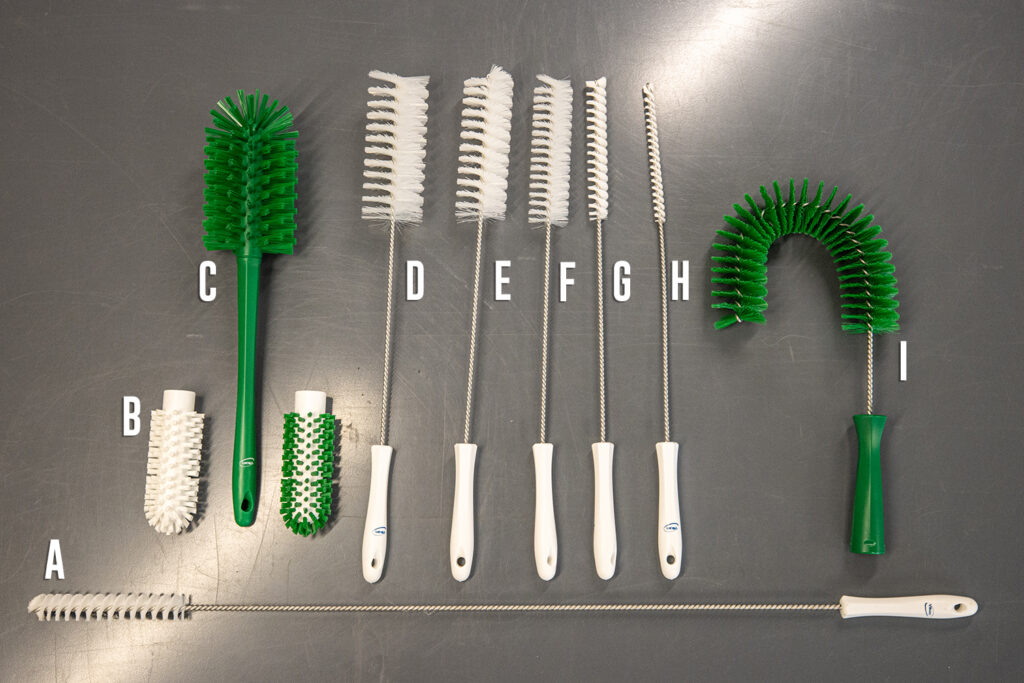
Tank Brush
This design has bristles that wrap around the head which are good for getting into corners or scrubbing walls of equipment.
Glove Brush
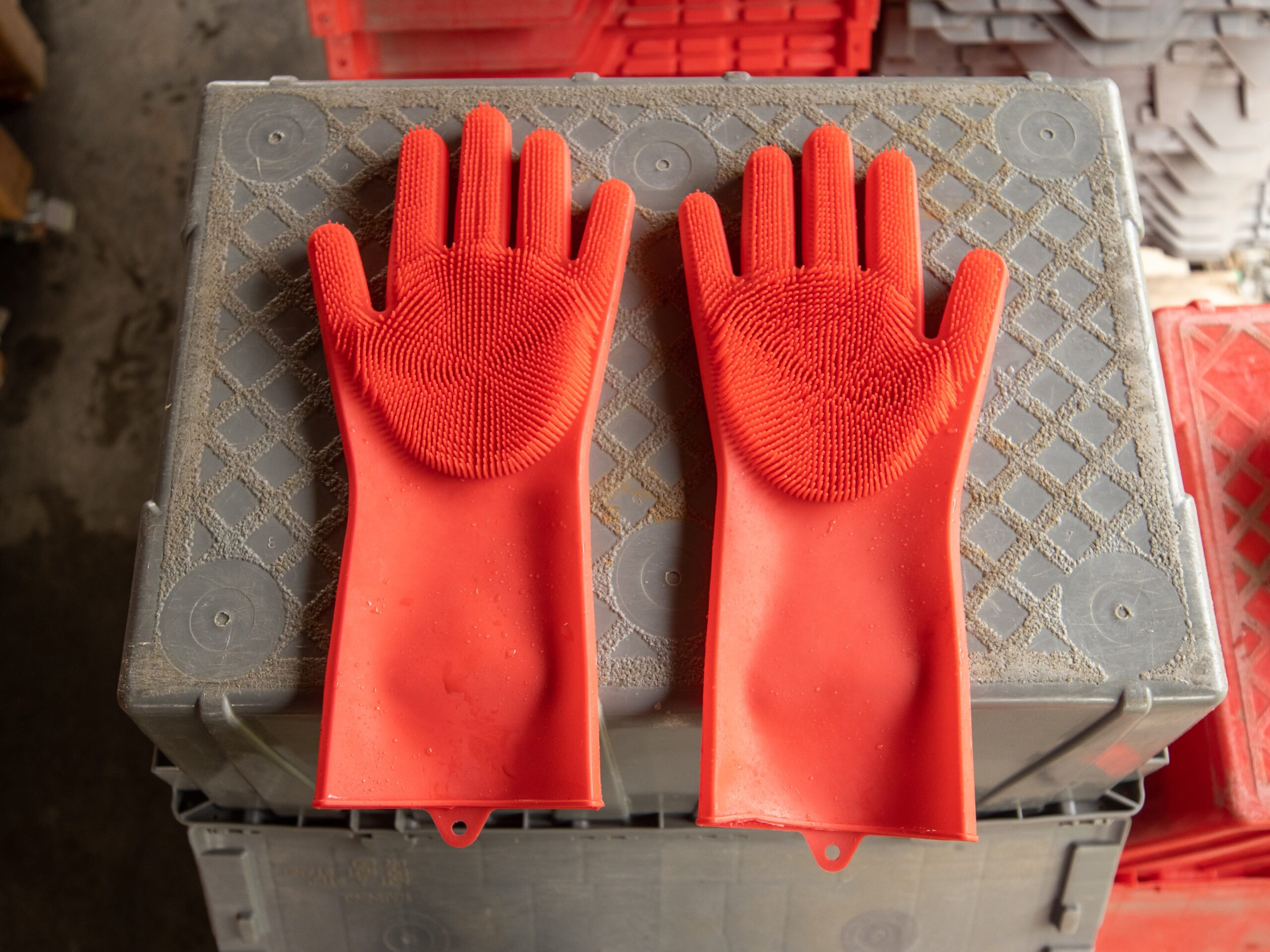
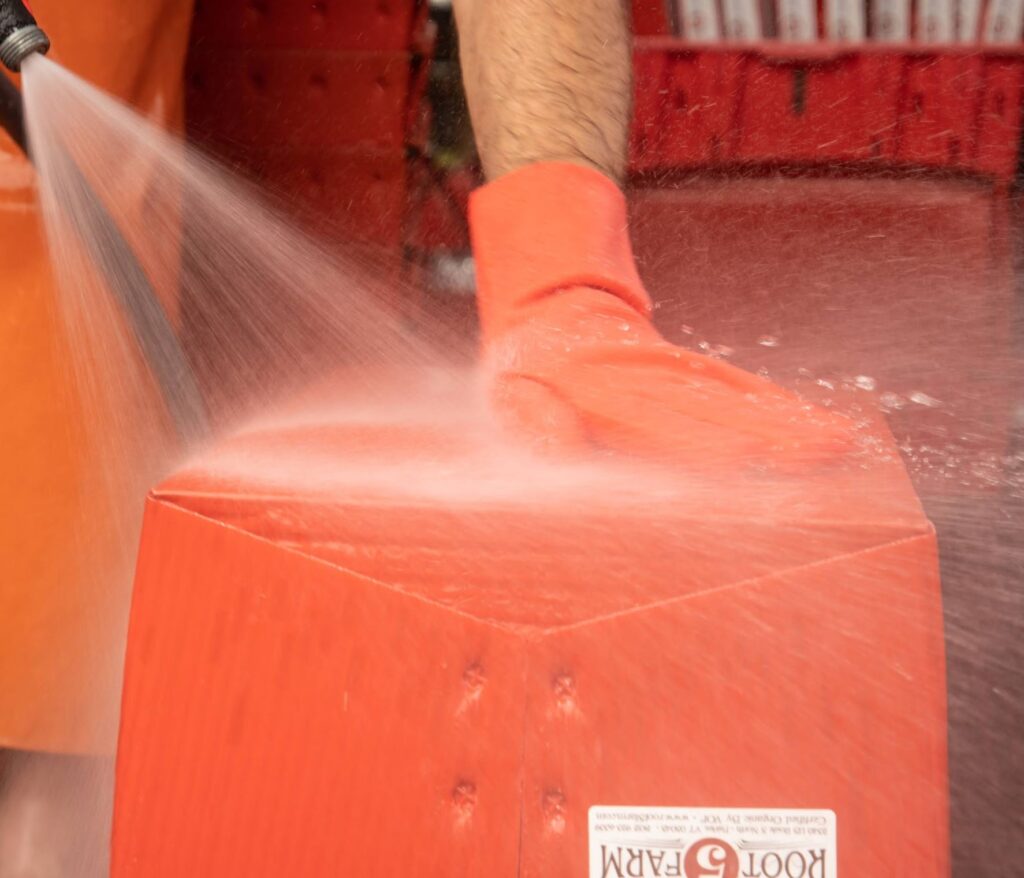
These silicone dish washing gloves have scrubbing pads on the palm and fingers to eliminate the need for reaching for a separate brush.
Brooms
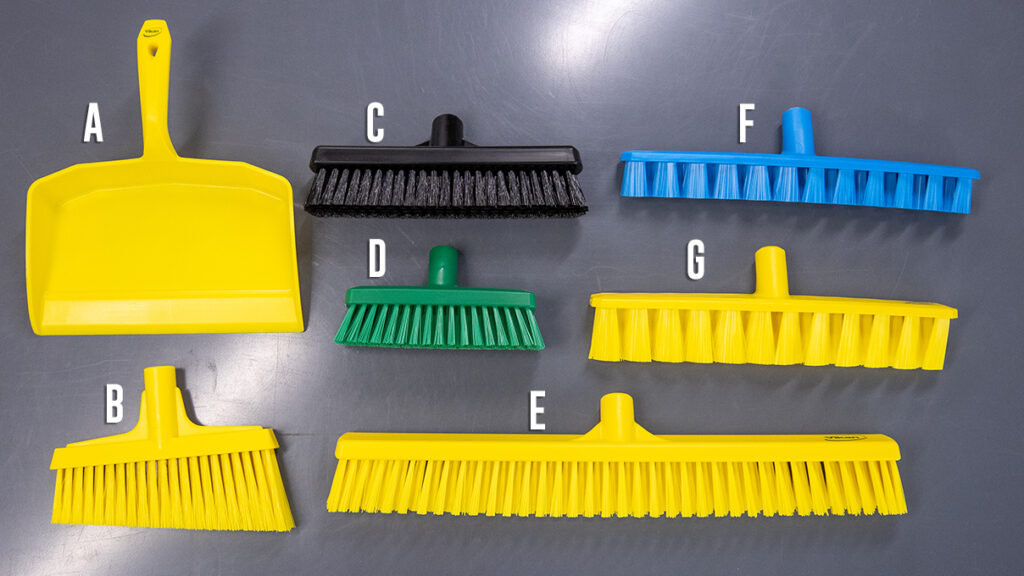
Floor Broom – Used for sweeping the open floor or large surfaces or spaces.
Angled broom – Gets into corners or smaller spaced with greater ease.
Deck Brush – Like a small broom but meant for scrubbing, not just sweeping.
Scrapers
Scrapers are helpful for getting stubborn and dried debris off of surfaces when doing deep cleans. Scrapers are available in both plastic or metal, hand held or extendable with a longer handle that can easily be screwed on to many of the tools.
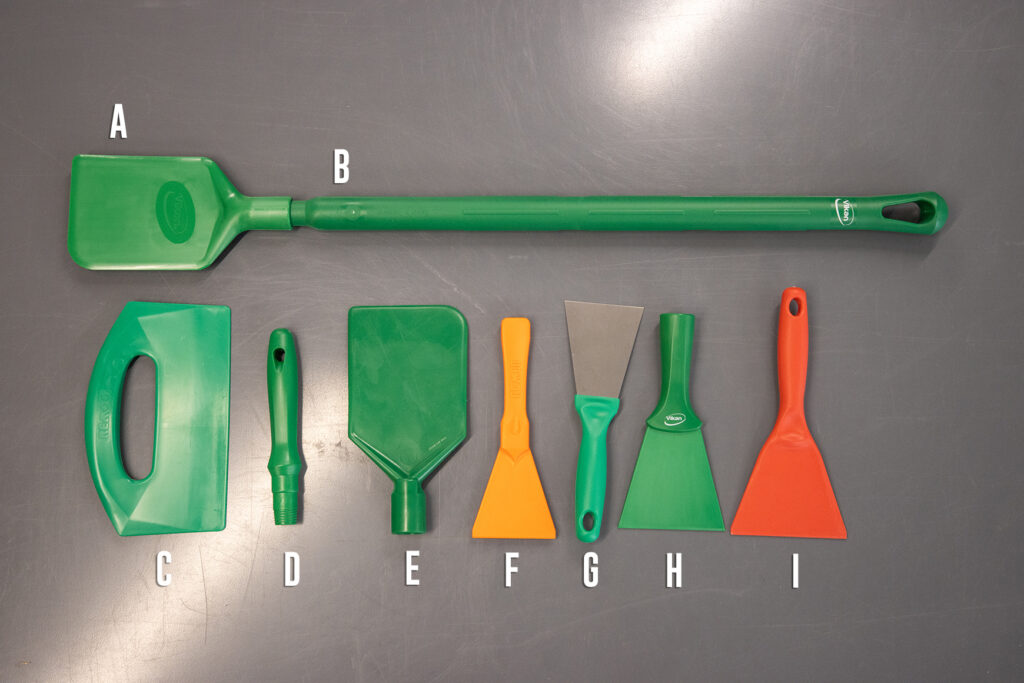
Squeegees
Surface squeegee – Handheld squeegees are great for sweeping water off of counters and tables. They can remove more water than a rag or sponge more easily and allow the surface to dry faster.
Floor squeegee – You do get what you pay for in floor squeegees. Fancier ones are easier to keep clean, and have a softer rubber edge making better contact with the floor. That being said, a basic and cheap squeegee may be just the tool you need to help rid of water especially if you’re not pushing the puddles off your concrete currently.
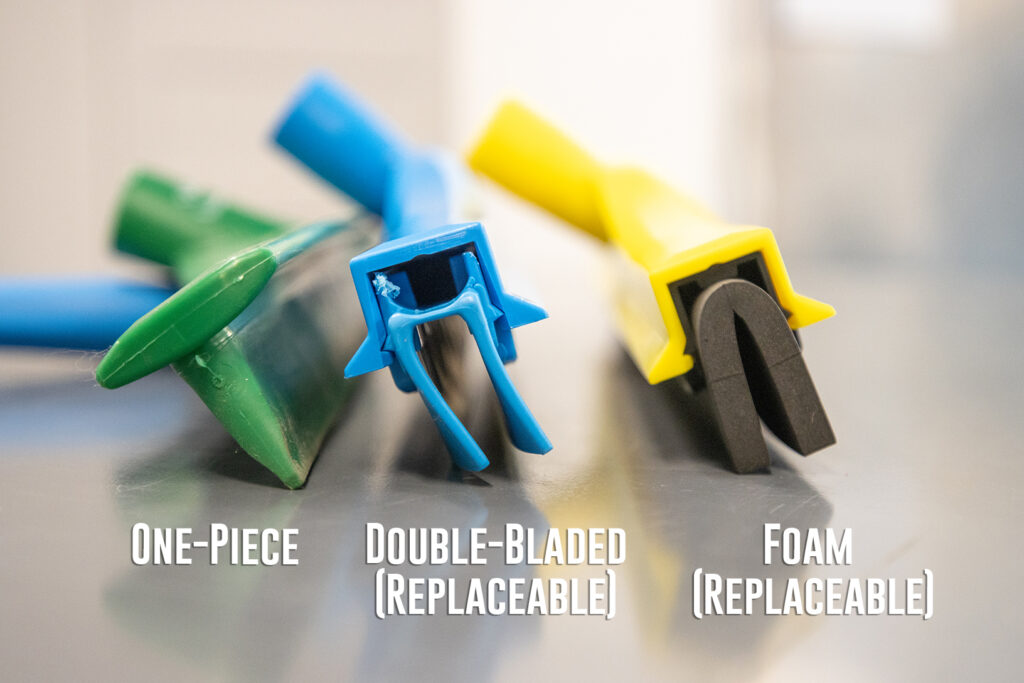
Mops, Sponges & Scrubbers
Mops are needed to scrub floors when things are dried on and a broom just isn’t cutting it. By adding water and a detergent you can get your floor to another level of clean by using a mop.
Sponges are like a mop for smaller surfaces. They hold soapy water in them to aid in scrubbing or spot cleaning small equipment. These often don’t hold up very long and should be considered a disposable solution.
Additionally there are scrubbing pads available for use with either a handheld holder or one that can be attached to a handle. Sponges and scrapers are excellent for taking off material but often considered a one time use as the are porous and don’t always come clean after use.
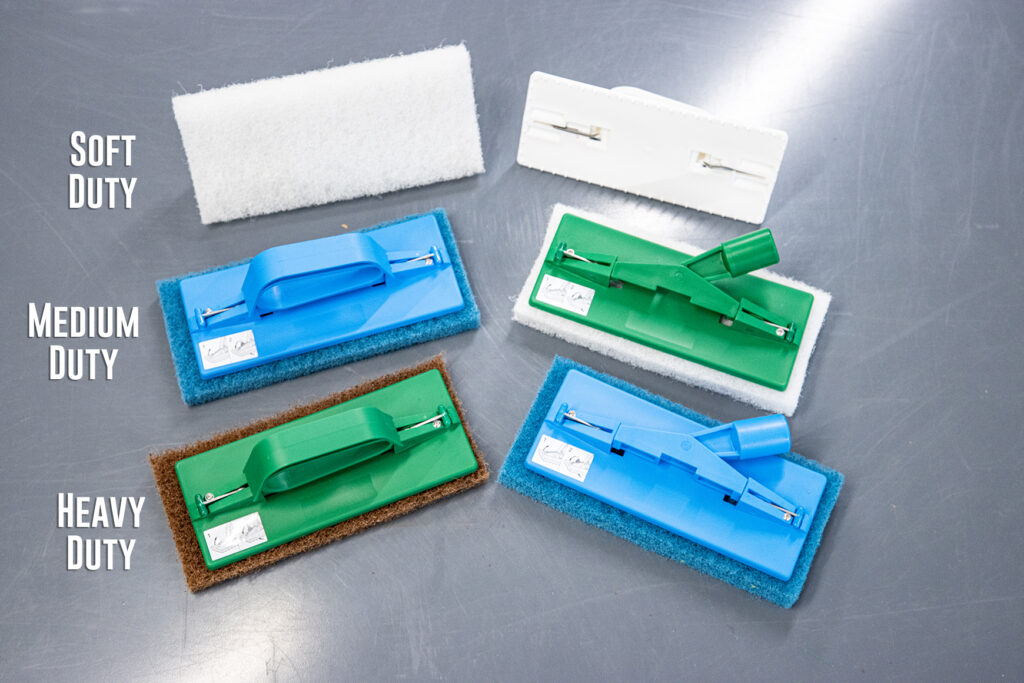
These 10” utility scrubbers are available in soft, medium or heavy duty for big scrubbing jobs either by hand or with a long pole. The pads are replaceable and meant to be “one time use.”
Buckets & Caddies
Almost any ole bucket without holes will do for cleaning, though you may consider dedicating one or two specifically for cleaning purposes to keep them clean and available when needed. This also can help prevent cross-contamination. A unique color keeps it identifiable as the cleaning bucket and reduces the chance of it walking off and being used for something else.
In addition to a bucket used for soapy water, or sanitizer solution, another bucket or caddy may be helpful to keep all the tools in one location as a ready-to-go kit. Make sure all your tools are cleaned, sanitized and dry before packing them up.
Shelves & Hangers
Having the right tools in the right location makes it easier to find the tools and promote the use of them. When the brush is right next to the equipment it’s easier for everyone to find it and it is more likely to be used. There are a variety of cleaning carts, shelves or hangers to aid in organizing these cleaning supplies. The most common hanger is a three hook hanger to hold a broom, brush, and squeegee. Often placed near the door since cleaning the floors happens at the end of the day just before you leave the premises. Vikan has a bucket bracket that holds their buckets upside down with a hook for the lid so everything can dry between uses.
Another organizational unit is a shelf to hold the soap, and a few hooks to hold smaller brushes. Placing this near a sink is good for organization and promoting cleaning.
There are also wire hangers made just for spray bottles, gallon jugs or gloves, so they have a dedicated location for storage and use.
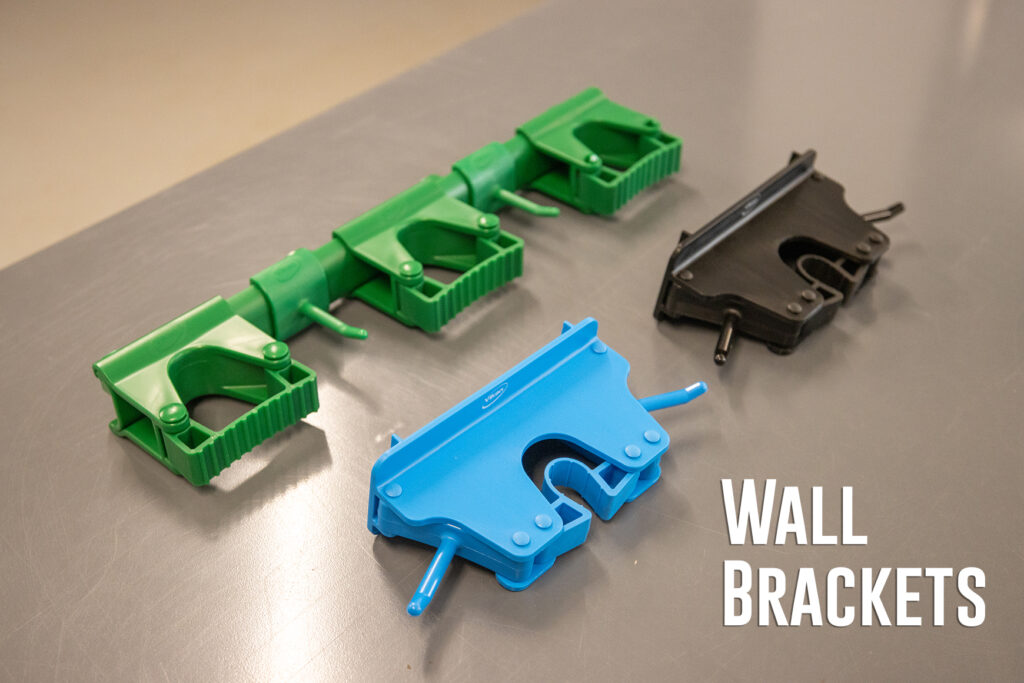
Accompanying Tools
Hoses & Sprayers
Having access to water makes cleaning easier. Using a high quality hose that’s in an easy to use location is key in a wash/pack environment. Read our blog post on hoses for specifics about hoses, reels, and nozzles.
Pressure Washers: Pressure or power washers can be a great tool for removing heavy build up on equipment or tools. Their use in/around a packshed needs to be used with caution as they can aerosolize and spread microorganisms and foodborne pathogens which can contaminate large areas. Use outside in a dedicated area to prevent overspray on clean equipment.
Cold weather tip: Consider running hot water to your wash station, this makes playing in the water almost fun in the winter.
Fans & Circulation
Drying is an important step in the cleaning process either for the packshed or when washing totes. Fan can do a great job at keeping the air moving to dry out floors, bins, or make the space more enjoyable on hot days.
Types of Fans
- Floor fans (Carpet blowers)
- Pedestal fans
- Ceiling fans
Dry Cleaning
Cleaning doesn’t always require water. Oftentimes brooms, bench brushes, with dustpans, or shopvac’s can also be effective at removing dry dust and dirt from equipment or facilities.
PPE
Commercial cleaners and sanitizers are often sold as concentrates and pose a chemical risk and need to be handled with caution. Be sure to read the label and follow the instructions for the products you choose for your personal protection. Proper personal protective equipment (PPE) should be worn as instructed including gloves, goggles, aprons, and other protective apparel to protect your skin.
Cold weather tip: Danielle Allen of Root 5 Farm shares that their crew really likes using long sleeve gloves, and aprons to keep them selves dry in the colder months.
Inspection
Other tools that may aid in thorough cleaning may include flashlights, portable work lights or flood lights to see in hard to reach locations. A step stool, or spring clamp to access hard to reach areas or hold flaps out of the way. Mirrors can be on an extendable handle to reach further than you may be able to get at with your arms.
Detergents
There are specific detergents that work well for cleaning up after produce and there are other options that go deeper than household dish soap.
There are fancier soaps ($200/L) that offer low foaming but the benefits may not outweigh the cost.
Labeling
Common tools used for labeling on the farm include:
- Laminated cards or posters
- Label maker
- Color coding (even with electrical tape or spray paint)
- Chalkboard markers
- Grease Pencil
- Permanent market
- Masking tape
Quick tip: Place your farm label on the handles of totes (or other upper edge) to remain to be seen when stacked.
Color Coding
The 5 core colors commonly available for cleaning tools are: red, green, yellow, white and blue. Select tools are available in additional colors.
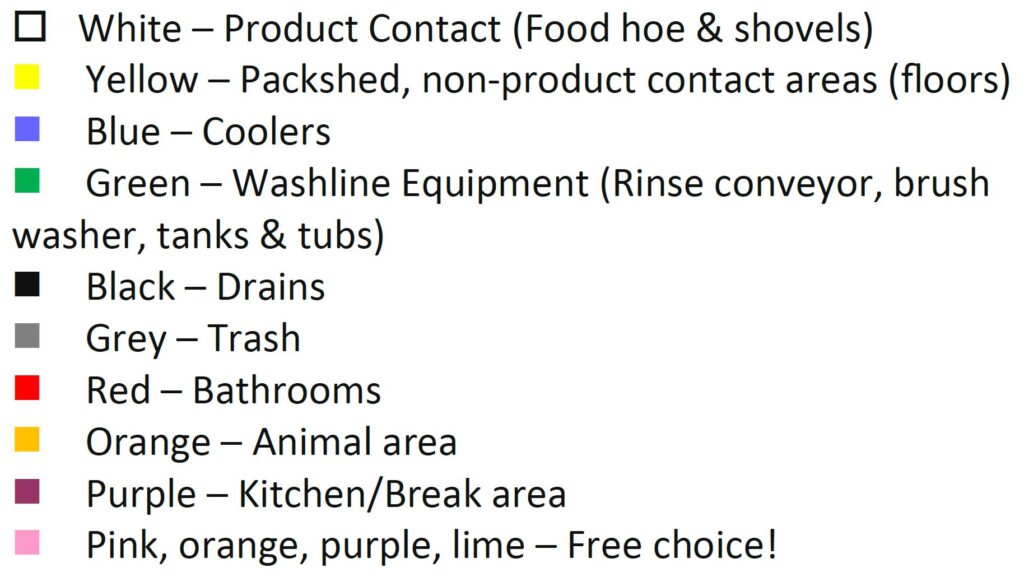
Sanitizers
Sanitizers need to be selected and used according to their label. as The concentration of a product used in vegetable wash water will be different that that used on food contact surfaces. To learn more about the process of cleaning and sanitizing and common sanitizers, read A Guide to Cleaning, Sanitizing, and Disinfecting for Produce Farms.
Dispensing and applying sanitizers is made easier with appropriate and dedicated containers. To learn more about the options, read Safely Dispensing Sanitizers.
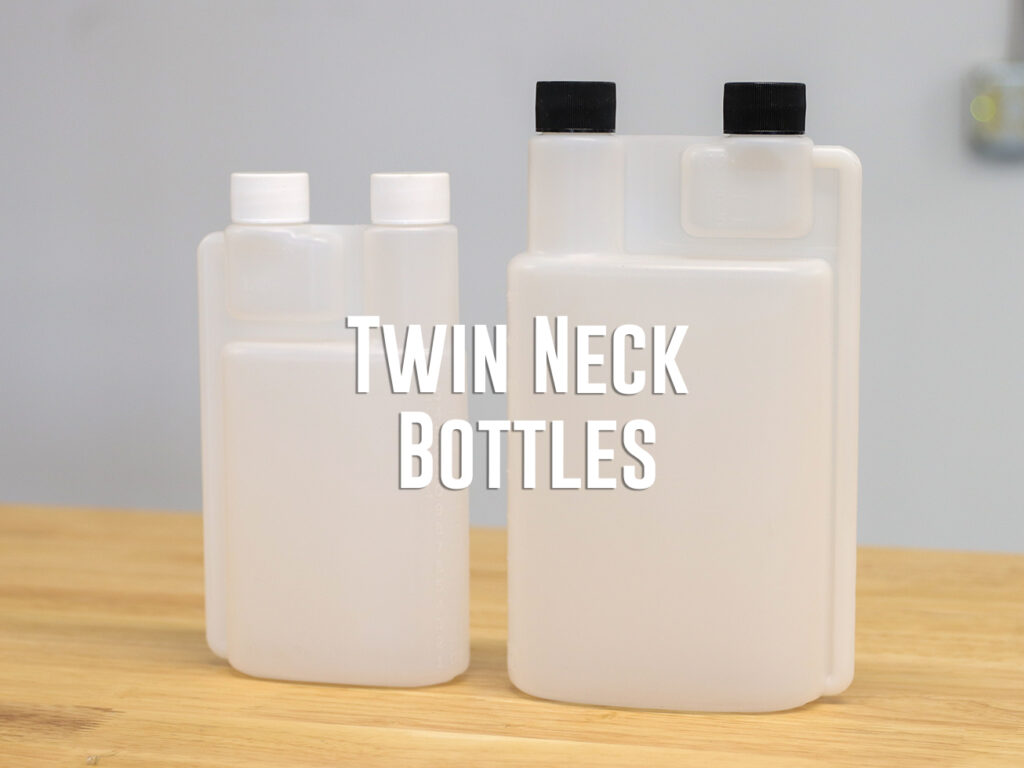
Spray Bottles & Rags
Spray bottles can be useful to mix up the correct concentration of sanitizer for cleaning primary food contact surfaces.
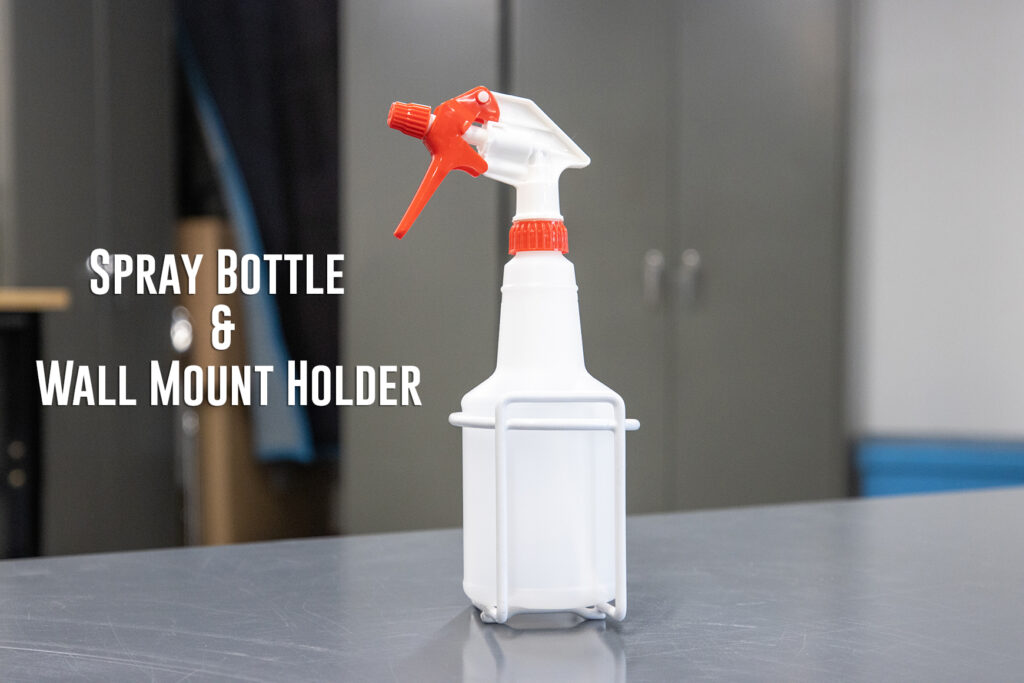
Retailers Carrying Cleaning Supplies
Different retailers display their products in various ways, and downloading the manufacturers buyers guide to find the part numbers you are looking for is one of the best ways to find exactly what you are looking for. This is available directly from Remco’s home page.
Once you have the manufacturers part number you can find the products through a variety of online retailers, who may also have a product catalog which may be easier to use in order to find what you are looking for. Potential vendors include:
- RS Quality
- Swish (Vermont distributor)
- Webstaurant
- Grainger
- Uline
- Zoro
- Union Jack Tools
- Nelson Jameson
- Local hardware stores
- Big box building supply stores
Video Overview of Tool Options
If you are looking for additional visuals of the mentioned products you can see them here in this video where we provide an overview of some of the tools available from Vikan/Remco products.
Share this post using this short link! go.uvm.edu/cleaningtools
Looking for more resources?
This publication was produced as part of the SCRUB Project (Cleaning and Sanitizing Resources for yoUr farm Business). For more cleaning and sanitizing resources visit our project page go.uvm.edu/scrubresources
Beth Demmings’ Cleaning Presentation Slides from Geneva Hygienic Design Workshop
Hygienic Design of Food Industry Brushware
Acknowledgments
This resource was developed as part of the Food Safety Outreach Program under grant number 2020-70020-33003 from the USDA National Institute of Food and Agriculture and also funded, in part, by the USDA Northeast Sustainable Agriculture Research and Education program through award LNE19-375 and by the Food and Drug Administration through The Vermont Agency of Agriculture Food and Markets via the Integrated Extension Educational Programming in Support of the VAAFM Produce Program Grant 02200-FSMA-2018-01. The views expressed in the publication do not necessarily reflect the official policies of the U.S. Department of Agriculture, the U.S. Department of Health and Human Services or the Vermont Agency of Agriculture; nor does any mention of trade names, commercial practices, or organization imply endorsement by the United States Government or the State of Vermont. It is offered without regard to race, color, religion, sex, sexual orientation, gender identity, national origin, disability, protected veteran status, or any other category legally protected by federal or state law.

